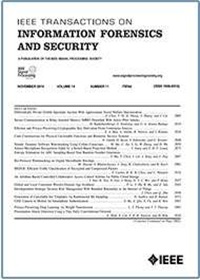Hierarchical Cross-Modal Image Generation for Multimodal Biometric Recognition With Missing Modality
IF 6.3
1区 计算机科学
Q1 COMPUTER SCIENCE, THEORY & METHODS
IEEE Transactions on Information Forensics and Security
Pub Date : 2025-04-10
DOI:10.1109/TIFS.2025.3559802
引用次数: 0
Abstract
Multimodal biometric recognition has shown great potential in identity authentication tasks and has attracted increasing interest recently. Currently, most existing multimodal biometric recognition algorithms require test samples with complete multimodal data. However, it often encounters the problem of missing modality data and thus suffers severe performance degradation in practical scenarios. To this end, we proposed a hierarchical cross-modal image generation for palmprint and palmvein based multimodal biometric recognition with missing modality. First, a hierarchical cross-modal image generation model is designed to achieve the pixel alignment of different modalities and reconstruct the image information of missing modality. Specifically, a cross-modal texture transfer network is utilized to implement the texture style transformation between different modalities, and then a cross-modal structure generation network is proposed to establish the correlation mapping of structural information between different modalities. Second, multimodal dynamic sparse feature fusion model is presented to obtain more discriminative and reliable representations, which can also enhance the robustness of our proposed model to dynamic changes in image quality of different modalities. The proposed model is evaluated on three multimodal biometric benchmark datasets, and experimental results demonstrate that our proposed model outperforms recent mainstream incomplete multimodal learning models.为缺失模态的多模态生物识别生成分层跨模态图像
多模态生物特征识别在身份认证任务中显示出巨大的潜力,近年来引起了越来越多的关注。目前,大多数现有的多模态生物识别算法都要求测试样本具有完整的多模态数据。然而,它经常遇到缺少模态数据的问题,从而在实际场景中遭受严重的性能下降。为此,我们提出了一种基于缺失模态的手掌纹和掌纹多模态生物识别的分层跨模态图像生成方法。首先,设计分层跨模态图像生成模型,实现不同模态的像素对齐,重建缺失模态的图像信息;具体而言,利用跨模态纹理传递网络实现不同模态之间的纹理样式转换,然后提出跨模态结构生成网络建立不同模态之间结构信息的关联映射。其次,提出了多模态动态稀疏特征融合模型,获得了更具判别性和可靠性的表征,增强了模型对不同模态图像质量动态变化的鲁棒性;在三个多模态生物特征基准数据集上对该模型进行了评估,实验结果表明,该模型优于目前主流的不完全多模态学习模型。
本文章由计算机程序翻译,如有差异,请以英文原文为准。
求助全文
约1分钟内获得全文
求助全文
来源期刊

IEEE Transactions on Information Forensics and Security
工程技术-工程:电子与电气
CiteScore
14.40
自引率
7.40%
发文量
234
审稿时长
6.5 months
期刊介绍:
The IEEE Transactions on Information Forensics and Security covers the sciences, technologies, and applications relating to information forensics, information security, biometrics, surveillance and systems applications that incorporate these features
 求助内容:
求助内容: 应助结果提醒方式:
应助结果提醒方式:


